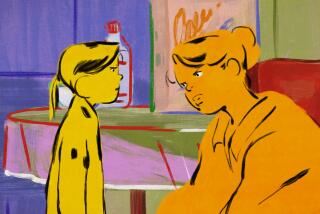Animated discussions in 2013 Oscars
Two of the season’s animated films were inspired by popular children’s books, both of which portray refugees from the modern world but otherwise could hardly be more different in style and sensibility. “Cloudy With a Chance of Meatballs 2” ricochets about with wall-to-wall wordplay before gorgeous stylization. “Ernest and Célestine” is a sweetly rendered prequel to the tender “cocoon” spun by the French book series, played out on a watercolor canvas.
‘Cloudy With a Chance of Meatballs 2’
“Cloudy With a Chance of Meatballs 2” co-director Kris Pearn has spent more than eight years playing with food.
PHOTOS: Best and worst moments from 2013 Oscars
“When we were finishing the first one, we had a whole different ending. We had a giant food kraken in the water,” says the head of story on the original 2009 hit. For the sequel, “we got really excited by the possibility of doing that film. But we quickly realized we had to make the food empathetic, so it shifted from a monster movie to a noble-savage movie.”
In the sequel, the FLDSMDFR (or Flint Lockwood Diatomic Super Mutating Dynamic Food Replicator, for long) has evolved to churn out not just food but sentient entrees (sentrees?), or “foodimals,” crazy combinations of animals and edibles. Cue the puns.
“People either love or hate ‘em,” notes Pearn with a smile of the wordplay that birthed such creatures as tacodiles, apple piethons and flamangos. “I definitely liked the susheep.”
As foodies will tell you, texture is important.
“In ‘Cloudy I,’ we had this conceit that all the food had to be delicious. So we were looking at a lot of food photography and a lot of photo-real textures,” Pearn says. “Going into ‘Cloudy 2,’ we wanted the jungle to always feel like a painting, as opposed to a jungle. So our food was photorealistic against a backdrop that was like a Mary Blair painting.”
The meat, though, may be the performances from the all-star voice cast, including James Caan as protagonist Flint’s massive fisherman father, Tim.
“I was really nervous on the day we were going to have him sing with the pickles,” Pearn says. “There was this weird Method thing happening in the room where [co-director Cody Cameron was] doing the pickles and James Caan was reading off of him and suddenly the two were acting.”
‘Ernest and Célestine’
Benjamin Renner was fresh out of film school at 25, working on the screen version of characters from a beloved French children’s book series, “Ernest and Célestine,” when the director quit. “I loved the project so much, I kept working on it,” Renner says. “At some point, the producer asked me, ‘Can you do it?’ Really, I thought he was crazy.”
But he had strong ideas about how to realize the adaptation of the stories from the late author Gabrielle Vincent. “We were really trying to find the way she was drawing,” he says. “Like, we used real watercolor to make the backgrounds. The animators, I was asking them to work with pleasure. I wanted to have love in the animation.”
INTERACTIVE: Best and worst Oscar moments since 2008
Renner led the animation team through crafting a teaser, which the producers liked enough to offer him the big chair, which he accepted only under the condition of working with an experienced co-director. He ended up with two: Vincent Patar and Stéphane Aubier of the stop-motion insanity “A Town Called Panic.” The choice worked out: “Ernest” won the César and was a huge box-office hit in France.
Vincent’s books gently depict slices of life with a bear and mouse in their house in the country. Renowned children’s author Daniel Pennac’s long-distance friendship with Vincent uniquely qualified him to write the screenplay.
“He knew her quite well and knew she was a very sensitive person, horrified by a lot of things and politics,” says Renner, now 30. “She was drawing a small paradise, like a small cocoon where she could draw her perfect life, the perfect relationship between the bear and the mouse.
“So Daniel wanted to start in a dark world, cynical, mean, and when we get in the house of Ernest and Célestine, it’s the house of Gabrielle Vincent. In the basement, all those objects, you can find in the books and in the house of Gabrielle Vincent. The paintings in the background are her paintings.”
More to Read
Only good movies
Get the Indie Focus newsletter, Mark Olsen's weekly guide to the world of cinema.
You may occasionally receive promotional content from the Los Angeles Times.






